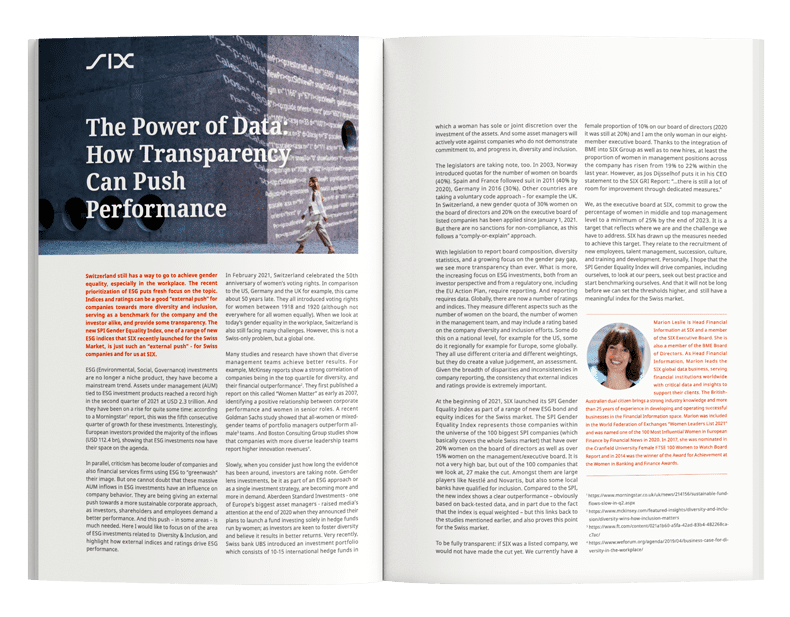Switzerland still has a way to go to achieve gender equality, especially in the workplace. The recent prioritization of ESG puts fresh focus on the topic. Indices and ratings can be a good “external push” for companies towards more diversity and inclusion, serving as a benchmark for the company and the investor alike, and provide some transparency. The new SPI Gender Equality Index, one of a range of new ESG indices that SIX recently launched for the Swiss Market, is just such an “external push” – for Swiss companies and for us at SIX.
ESG (Environmental, Social, Governance) investments are no longer a niche product, they have become a mainstream trend. Assets under management (AUM) tied to ESG investment products reached a record high in the second quarter of 2021 at USD 2.3 trillion. And they have been on a rise for quite some time: according to a Morningstar1 report, this was the fifth consecutive quarter of growth for these investments. Interestingly, European investors provided the majority of the inflows (USD 112.4 bn), showing that ESG investments now have their space on the agenda.
In parallel, criticism has become louder of companies and also financial services firms using ESG to “greenwash” their image. But one cannot doubt that these massive AUM inflows in ESG investments have an influence on company behavior. They are being giving an external push towards a more sustainable corporate approach, as investors, shareholders and employees demand a better performance. And this push – in some areas – is much needed. Here I would like to focus on of the area of ESG investments related to Diversity & Inclusion, and highlight how external indices and ratings drive ESG performance.
In February 2021, Switzerland celebrated the 50th anniversary of women’s voting rights. In comparison to the US, Germany and the UK for example, this came about 50 years late. They all introduced voting rights for women between 1918 and 1920 (although not everywhere for all women equally). When we look at today’s gender equality in the workplace, Switzerland is also still facing many challenges. However, this is not a Swiss-only problem, but a global one.
Many studies and research have shown that diverse management teams achieve better results. For example, McKinsey reports show a strong correlation of companies being in the top quartile for diversity, and their financial outperformance 2. They first published a report on this called “Women Matter” as early as 2007, identifying a positive relationship between corporate performance and women in senior roles. A recent Goldman Sachs study showed that all-women or mixed-gender teams of portfolio managers outperform all-male 3 teams . And Boston Consulting Group studies show that companies with more diverse leadership teams report higher innovation revenues 4.
Slowly, when you consider just how long the evidence has been around, investors are taking note. Gender lens investments, be it as part of an ESG approach or as a single investment strategy, are becoming more and more in demand. Aberdeen Standard Investments – one of Europe’s biggest asset managers – raised media’s attention at the end of 2020 when they announced their plans to launch a fund investing solely in hedge funds run by women; as investors are keen to foster diversity and believe it results in better returns. Very recently, Swiss bank UBS introduced an investment portfolio which consists of 10-15 international hedge funds in which a woman has sole or joint discretion over the investment of the assets. And some asset managers will actively vote against companies who do not demonstrate commitment to, and progress in, diversity and inclusion.
The legislators are taking note, too. In 2003, Norway introduced quotas for the number of women on boards (40%). Spain and France followed suit in 2011 (40% by 2020), Germany in 2016 (30%). Other countries are taking a voluntary code approach – for example the UK. In Switzerland, a new gender quota of 30% women on the board of directors and 20% on the executive board of listed companies has been applied since January 1, 2021. But there are no sanctions for non-compliance, as this follows a “comply-or-explain” approach.
With legislation to report board composition, diversity statistics, and a growing focus on the gender pay gap, we see more transparency than ever. What is more, the increasing focus on ESG investments, both from an investor perspective and from a regulatory one, including the EU Action Plan, require reporting. And reporting requires data. Globally, there are now a number of ratings and indices. They measure different aspects such as the number of women on the board, the number of women in the management team, and may include a rating based on the company diversity and inclusion efforts. Some do this on a national level, for example for the US, some do it regionally for example for Europe, some globally. They all use different criteria and different weightings, but they do create a value judgement, an assessment. Given the breadth of disparities and inconsistencies in company reporting, the consistency that external indices and ratings provide is extremely important.
At the beginning of 2021, SIX launched its SPI Gender Equality Index as part of a range of new ESG bond and equity indices for the Swiss market. The SPI Gender Equality Index represents those companies within the universe of the 100 biggest SPI companies (which basically covers the whole Swiss market) that have over 20% women on the board of directors as well as over 15% women on the management/executive board. It is not a very high bar, but out of the 100 companies that we look at, 27 make the cut. Amongst them are large players like Nestlé and Novartis, but also some local banks have qualified for inclusion. Compared to the SPI, the new index shows a clear outperformance – obviously based on back-tested data, and in part due to the fact that the index is equal weighted – but this links back to the studies mentioned earlier, and also proves this point for the Swiss market.
To be fully transparent: if SIX was a listed company, we would not have made the cut yet. We currently have a female proportion of 10% on our board of directors (2020 it was still at 20%) and I am the only woman in our eight-member executive board. Thanks to the integration of BME into SIX Group as well as to new hires, at least the proportion of women in management positions across the company has risen from 19% to 22% within the last year. However, as Jos Dijsselhof puts it in his CEO statement to the SIX GRI Report: “…there is still a lot of room for improvement through dedicated measures.”
We, as the executive board at SIX, commit to grow the percentage of women in middle and top management level to a minimum of 25% by the end of 2023. It is a target that reflects where we are and the challenge we have to address. SIX has drawn up the measures needed to achieve this target. They relate to the recruitment of new employees, talent management, succession, culture, and training and development. Personally, I hope that the SPI Gender Equality Index will drive companies, including ourselves, to look at our peers, seek out best practice and start benchmarking ourselves. And that it will not be long before we can set the thresholds higher, and still have a meaningful index for the Swiss market.



Marion Leslie
Marion Leslie is Head Financial Information at SIX and a member of the SIX Executive Board. She is also a member of the BME Board of Directors. As Head Financial Information, Marion leads the SIX global data business, serving financial institutions worldwide with critical data and insights to support their clients. The British-Australian dual citizen brings a strong industry knowledge and more than 25 years of experience in developing and operating successful businesses in the Financial Information space. Marion was included in the World Federation of Exchanges “Women Leaders List 2021” and was named one of the 100 Most Influential Women in European Finance by Financial News in 2020. In 2017, she was nominated in the Cranfield University Female FTSE 100 Women to Watch Board Report and in 2014 was the winner of the Award for Achievement at the Women in Banking and Finance Awards.
